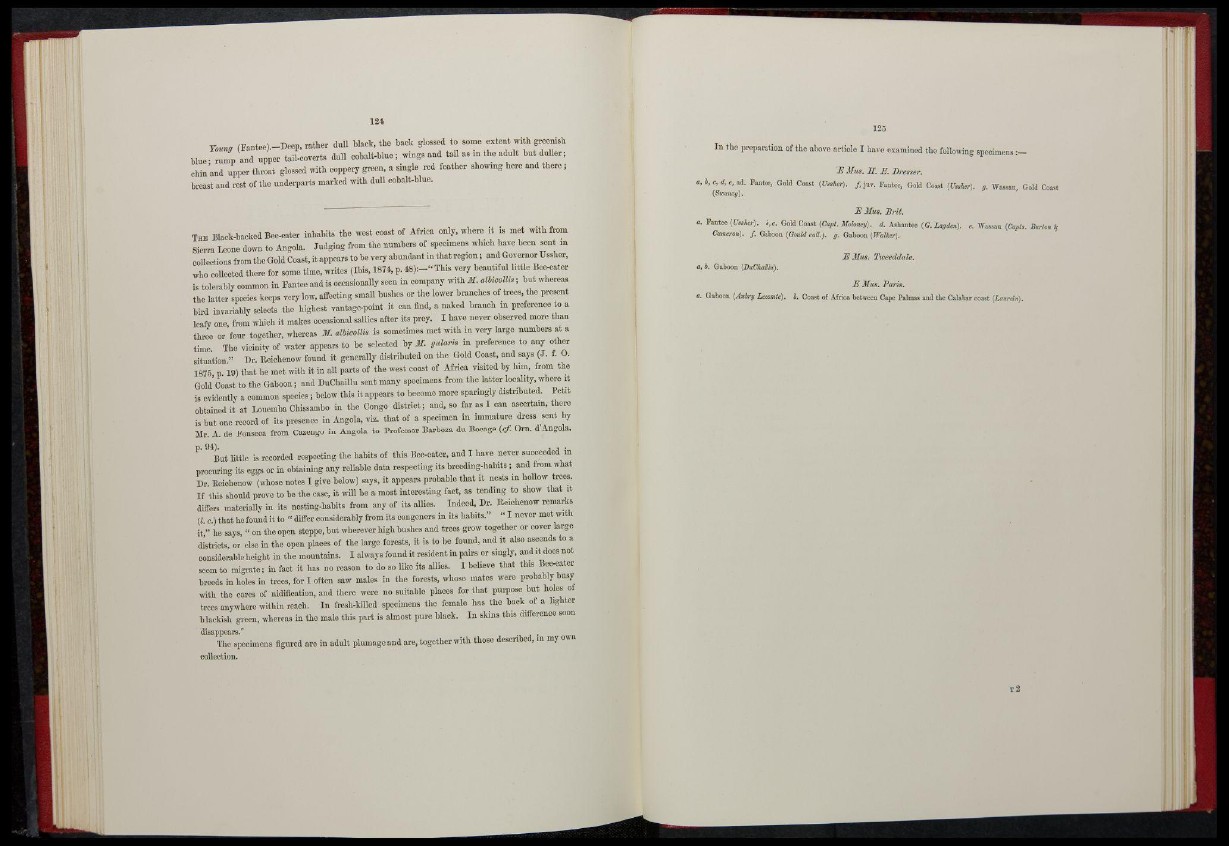
Youna (Fantee).-Deep, rather dull black, the back glossed to some extent with greenish
Mae- rump and upper tail-coverts dull cobalt-blue; wings and tail as in the adult but duller;
chin'and upper throat glossed with coppery green, a single red feather showing here and there;
breast and rest of the underparts marked with dull cobalt-blue.
THE Black-backed Bee-eater inhabits the west coast of Africa only, where it is met with from
Sierra Leone down to Angola. Judging from the numbers of specimens which have been sent in
collections from the Gold Coast, it appears to be very abundant in that region; and Governor Ussher,
who collected there for some time, writes (Ibis, 187-4, p. 48):—" This very beautiful little Bee-eater
is tolerably common in Pantec and is occasionally seen in company with II. albicollis; but whereas
the latter species keeps very low, affecting small bushes or the lower branches of trees, the present
bird invariably selects the highest vantage-point it can find, a naked branch in preference to a
leafy one, from which it makes occasional sallies after its prey. I have never observed more than
three or four together, whereas 31. albicollis is sometimes met with in very largo numbers at a
time. The vicinity of water appears to be selected by 3£. gularis in preference to any other
situation." Dr. Beiehenow found it generally distributed on the Gold Coast, and says (J. f. O.
1875, p. 19) that he met with it in all parts of the west coast of Africa visited by him, from the
Gold Coast to the Gaboon; and DuChaillu sent many specimens from the latter locality, where it
is evidently a common species ; below this it appears to become more sparingly distributed. Petit
obtained it at Louemba Chissambo in the Congo district; and, so far as I can ascertain, there
is but one record of its presence in Angola, viz. that of a specimen in immature dress sent by
Sir. A. de Ponscca from Cazeugo in Angola to Professor Barboza du Bocage (cj\ Orn. d'.Vngola,
p. 94).
But little is recorded respecting the habits of this Itec-eater, and I have never succeeded in
procuring its eggs or in obtaining any reliable data respecting its breeding-habits ; and from what
Dr. Beiehenow (whose notes I give below) says, it appears probable that it nests in hollow trees.
If this should prove to be the case, it will be a most interesting fact, as tending to show that it
differs materially iu its nesting-habits from any of its allies. Indeed, Dr. Beiehenow remarks
(/. c.) that he found it to " differ considerably from its congeners in its habits." " I never met with
it," he says, " on the open steppe, but wherever high bushes and trees grow together or cover large
districts, or else in the open places of tin; large forests, it is to bo found, and it also ascends to a
considerable height in t h e mountains. I always found it resident in pairs or singly, and it does not
seem to migrate; in fact it has no reason to do so like its allies. I believe that this Bee-eater
breeds in holes in trees, for I often saw males in the forests, whose mates were probably busy
with the cares of nidification, and there were no suitable places for that purpose but holes of
trees anywhere within reach. In fresh-killed specimens the female has the back of a lighter
blackish green, whereas in the male this part is almost pure black. In skins this difference soon
disappears."
The specimens figured arc in adult plumage and arc, together with those described, in my own
collection.
In the preparation of the above article I have examined the following specimens :—
T 2
E 3Ius. II. E. Dresser.
b, c, d, e, ad. Fantcc, Gold Coast (Usaher). ƒ, juv. Fantcc, Gold Coast (Uwher). g. Wassau, Gold Coast
(Swamy).
E Mug. Brit.
. Fantee (Uasher). b,c. Gold Coast (Capt. Moloney), d. Ashantce (G. Lagden). e. Wassau (Capts. Burton if
Cameron), ƒ. Gaboon (Gould coll.). g. Gaboon (fl'alkcr).
EMus. Ttoeeddale.
, b. Gaboon (DuChaiUu).
E Mas. Paris.
. Gaboon (Aubry Lecomte). b. Coast oE Africa between Cape Palmas and the Calabar coast (Laurein).